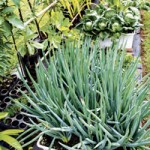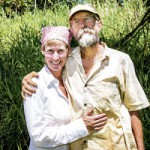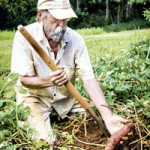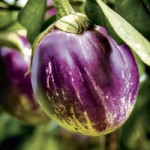Kumu Aina, The Land As Teacher
- Plants thrive after Sun and Lisa Fuller have cleared the land
- Onions, cabbage, chard and lettuce spring from EarthBoxes. Daniel Lane photos
- A “before” picture of Lisa Fuller and Sun standing in front of waist-high grass
- Sun harvesting 2-month-old sweet potatoes
- Eggplant grown from One Song seed
The April 26 issue of MidWeek Kaua‘i featured daikon radish from One Song Farm. It was the end of an era for farmers Lisa Fuller and Sun. But in just two months, they have relocated from Moloa‘a to Wai Koa Plantation in Kilauea, and made incredible progress with their new property Kumu Aina.
“Kumu Aina means ‘land as teacher,'” says Sun of his educational-based farm. “Our job is to inspire, so we lessen our footprint here. We want to take it to the next level, and work towards total food security for Kaua‘i.”
Sun has been an organic farmer on Kaua‘i for 22 years, and one of the educational projects the couple is working on is in partnership with their neighbor Malama Kaua‘i — a nonprofit that advocates, educates and drives action toward a sustainable Kaua‘i.
“We are creating incubation plots where new farmers can learn under the tutelage of a master organic farmer,” says Fuller, who will teach along with Sun. “It’s a place for beginning farmers to practice their skills.” The project is still being organized, and interested parties should call Malama Kaua‘i at 828-0685.
Kumu Aina, a former plantation plot overgrown with grass and weeds, is now a productive space with herbs, vegetables and flowers. In two months, sweet potatoes — which normally take six months — have grown to an edible size. Kale, beets, collards, malabar spinach and beans thrive in a 25-square-foot personal garden.
Onions, cabbage, chard and lettuce spring from EarthBoxes, and a small circular garden contains taro, bushy shiso and towering basil with pollen-laden bees. Plants that were brought from Moloa‘a are going to seed, which will be collected and added to their large seed bank.
Since the focus is on teaching, market gardens will be less productive. Growing from seeds saved at One Song Farm, and under the name of One Song Produce, Sun and Fuller will sell at the Namahana farmers market in about a month’s time.
Meanwhile, you can attend their “Start Up Gardening” workshop Sunday, Sept. 30. Topics include soil testing and preparation; controlling weeds and grass; disease and insect control, making compost and monitoring your garden from seed to table.
“Soil is the biggest thing that we’ll be talking about,” says Fuller. “If your soil isn’t healthy and active, you’ll get rot, pests and disease. There’s no point in putting anything in the ground until you know what you’re dealing with.”
Before deciding where to plant their gardens, Sun and Fuller gathered soil from three locations, and had it tested. Testing soil reveals soil pH, available nutrients such as nitrogen, boron, copper, manganese, zinc and organic carbon, and exposes toxins such as aluminum and soil salinity. Knowing this, issues can be addressed before they become problems.
“Right out of the gate, we’re finding that we’ve got nematodes,” says Fuller of the microscopic roundworms that are detrimental to plant health. “Plus, we just had half of our garden eaten by slugs, overnight.”
“In our workshop, we’re covering things that would make most people quit,” Sun says: “weeds, slugs, nematodes and how to do it in a small space and be successful.”
Kumu Aina
635-3020
Marta Lane is a freelance food writer. For more information, visit TastingKauai.com.








